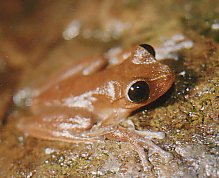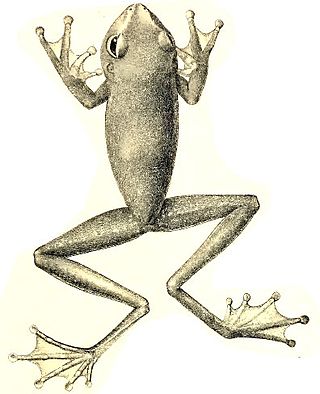
Litoria is a genus of hylid tree frogs, sometimes collectively referred to as Australasian treefrogs, that are native to Australia, the Bismarck Archipelago, the Solomon Islands, New Guinea, the Lesser Sunda Islands, and the Moluccan Islands. They are distinguishable from other tree frogs by the presence of horizontal irises, no pigmentation of the eyelids, and their distribution east and south from Wallacea. Over one hundred species are recognised and new species are still being added, such as the Pinocchio frog discovered in 2008 and described in 2019.

Nyctimystes is a genus of tree frogs in the subfamily Pelodryadinae of the family Hylidae. They are principally Papuan species, but also inhabit islands in the Moluccas. All species in this genus have one distinct feature that separates them from other species in the family, the lower eyelid is marked with pattern of lines, veins, or dots. This feature presumably acts as camouflage when the frogs are at rest during the day.

The white-lipped tree frog is a species of frog in the subfamily Pelodryadinae. It is the world's largest tree frog and is found in Australia. Other common names include the New Guinea treefrog, giant tree frog, and Australian giant treefrog.

Choerophryne is a genus of microhylid frogs, commonly known as Torricelli mountain frogs, endemic to New Guinea. These frogs are small, with the body length measured from snout to vent between 11 and 23 mm.
The multi-coloured tree frog or multi-coloured frog is a species of frog in the subfamily Pelodryadinae. It is endemic to West Papua, Indonesia. Its natural habitats are subtropical or tropical moist lowland forests, subtropical or tropical moist montane forests, swamps, and freshwater marshes. It is threatened by habitat loss.

Nyctimystes montanus is a species of frog in the subfamily Pelodryadinae. It is endemic to the Arfak Mountains, located in the Bird's Head Peninsula of northwestern New Guinea. This species is only known from its type locality. There are no records of this species after it was described in 1878, perhaps because of lack of surveys.
Nyctimystes persimilis, also known as the Milne big-eyed treefrog, is a species of frog in the subfamily Pelodryadinae of the family Hylidae. It is endemic to Papua New Guinea and known from Mount Dayman and Mount Simpson in the Owen Stanley Range.
Nyctimystes tyleri is a species of frog in the subfamily Pelodryadinae of the family Hylidae. It is endemic to Papua New Guinea and only known from its type locality, Gapaia Creek, between Garaina and Saureli, in the Morobe Province. The specific name honours Michael J. Tyler, an Australian herpetologist, "in recognition of his notable contributions to the systematics of Australo-papuan frogs." Common name Tyler's big-eyed treefrog has been coined for this species.
Djoko Tjahjono Iskandar is an Indonesian herpetologist who studies the amphibians of Southeast Asia and Australasia. He is a professor of biosystematics and ecology at Bandung Institute of Technology in West Java, Indonesia.
Nyctimystes dux is a species of frog in the subfamily Pelodryadinae. This fairly large tree frog is mainly green. It is endemic to the Huon Peninsula in Papua New Guinea. It was separated from Litoria graminea by Richards & Oliver, 2006.
Nyctimystes purpureolatus is a species of frog in the subfamily Pelodryadinae. It is endemic to New Guinea and is known from its type locality on the Tiri River, a small tributary of the Mamberamo River in West Papua, Indonesia, and from three locations in West Sepik Province, Papua New Guinea.
Callulops mediodiscus is a species of frog in the family Microhylidae. It is only known from the type locality in the upper Kikori Basin in the Southern Highlands Province, Papua New Guinea. The specific name refers to its most distinctive feature, the moderately enlarged discs on fingers and toes, although their function remains unknown as the specimens were collected on or near the ground.
Stegonotus is a genus of snakes in the family Colubridae. Species of the genus Stegonotus are native to Australia, Indonesia, and New Guinea.
The parachuting frog, or pale-eyed parachuting tree frog, is a species of frog found in New Guinea. It is in the Nyctimystes gramineus complex with the Pinocchio frog and montane Pinocchio frog.
Nyctimystes hunti is a species of tree frog in the subfamily Pelodryadinae. It is endemic to northern Papua New Guinea. Scientists have seen it only in Utai, Sanduan Province, but predict that also lives elsewhere on New Guinea.
Nyctimystes sauroni is a species of tree frog in the subfamily Pelodryadinae. It is endemic to Papua New Guinea. Scientists know it solely from the Kikori Integrate Conservation and Development Project area.
Nyctimystes kuduki is a species of tree frog in the sub-family Pelodryadinae. It is endemic to Papua New Guinea and is found in montane rainforests in Southern Highlands Province.
The northern creek frog is a frog endemic to Australia. It has been found in the Northern Territory, Western Australia, and Queensland.




